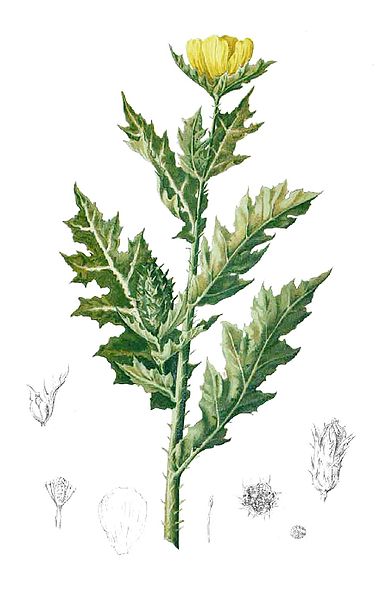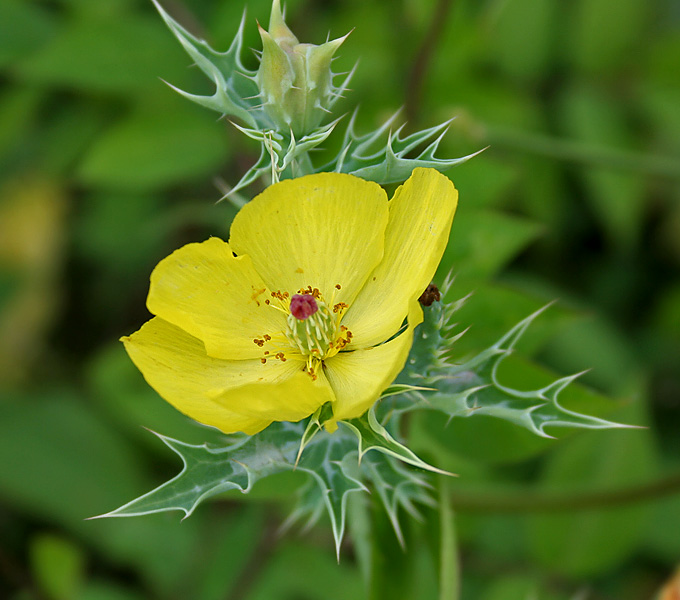 |
|
http://commons.wikimedia.org/wiki/File:Argemone_mexicana_Blanco1.187-cropped.jpg |
 |
| http://commons.wikimedia.org/wiki/User:J.M.Garg |
Translate this page:
Summary
A hardy pioneering poppy species with yellow flowers from Mexico and now widely naturalized in many parts of the world. Some very useful medicinal qualities and some suggestions that the leaves can be eaten. The seed oil is used for lighting and soap and potentially may be a Biodiesel. Common Names: Mexican pricklepoppy; Mexican pricklypoppy; Mexican thistle; prickly poppy; yellow thistle. Spanish: adormidera espinosa; cardo blanco; chicalote. French: argémone du Mexique; argemone mexicaine; pavot epineux. Portuguese: papoula-do-Mexico. Argentina: cardo amarillo. Bangladesh: Shialkata. Brazil: cardo-amarelo; cardo-santa; cardo-santa-maria; figo-do-inferno; papoula-de-espinho; papoula-espinhosa. Germany: Mexikanischer Stachelmohn. Haiti: chardon béni. India: agara; bharband; bharbhar; brahamadandi; bramandandu; kantakusama; katelisatyanasi; satyonasi. Indonesia: droedjoe; tjelangkringan. Italy: papavero messicano. Japan: Azami-Geshi. Kenya: ekijembajembe; mkumajalaga. Mauritius: chardon du pays. Mexico: chicalote. Myanmar: kye-ja. Netherlands: stekelpapaver. Niger: Boginahi; Dàyí gííwáá; Hákóórín kádà; Káákí rúwàn Allàh; Kàankámárkà tà bíí kà; kamukamu; Kánkààmáá; Karanko; Kùùrár fataakee; Kwarakko; Kwaranko; Wagiri; Wasiri. Nigeria: Boginahi; Dàyí gííwáá; Hákóórín kádà; Káákí rúwàn Allàh; Kàankámárkà tà bíí kà; kamukamu; Kánkààmáá; Karanko; Kùùrár fataakee; Kwarakko; Kwaranko; Wagiri; Wasiri. Pakistan: kanderi; kundiari; sialkanta. Paraguay: Cardo santo. Puerto Rico: cardosanto. South Africa: yellow-flowered Mexican poppy. Zimbabwe: umjelemani.
Physical Characteristics

 Argemone mexicana is a PERENNIAL growing to 0.6 m (2ft) by 0.5 m (1ft 8in).
Argemone mexicana is a PERENNIAL growing to 0.6 m (2ft) by 0.5 m (1ft 8in).
See above for USDA hardiness. It is hardy to UK zone 8. It is in flower from June to August, and the seeds ripen from July to September. The species is hermaphrodite (has both male and female organs). The plant is self-fertile.
Suitable for: light (sandy) soils, prefers well-drained soil and can grow in nutritionally poor soil. Suitable pH: mildly acid, neutral and basic (mildly alkaline) soils. It cannot grow in the shade. It prefers dry or moist soil and can tolerate drought.
UK Hardiness Map
US Hardiness Map
Synonyms
A. ochroleuca.
Plant Habitats
Cultivated Beds;
Edible Uses
Edible Parts: Leaves Oil
Edible Uses: Oil
Leaves[177] No further details are given but caution is advised, see the notes on toxicity at the top of the page.
References More on Edible Uses
Medicinal Uses
Plants For A Future can not take any responsibility for any adverse effects from the use of plants. Always seek advice from a professional before using a plant medicinally.
Alterative Analgesic Antispasmodic Antitussive Demulcent Emetic Expectorant Hallucinogenic
Purgative Sedative Skin Warts
The whole plant is analgesic, antispasmodic, possibly hallucinogenic and sedative[46, 61, 178, 181, 192, 254]. It contains alkaloids similar to those in the opium poppy (P. somniferum) and so can be used as a mild pain-killer[254]. The fresh yellow, milky, acrid sap contains protein-dissolving substances and has been used in the treatment of warts, cold sores, cutaneous affections, skin diseases, itches etc[207, 243, 254]. It has also been used to treat cataracts[254] and has been taken internally in the treatment of dropsy and jaundice[240, 243]. The root is alterative and has been used in the treatment of chronic skin diseases[240, 243]. The flowers are expectorant and have been used in the treatment of coughs and other chest complaints[254]. The seed is demulcent, emetic, expectorant and laxative[240, 243]. An infusion, in small quantities, is used as a sedative for children, but caution is advised since the oil in the seed is strongly purgative[254]. The seed has also been used as an antidote to snake poisoning[240, 243]. The pounded seeds, mixed with mustard oil, are applied externally to treat itchy skin[272]. The oil from the seed is demulcent and purgative[254, 272]. It has been used externally in the treatment of skin problems[240, 243, 272]. Caution is advised in the use of this oil, prolonged ingestion produces toxic effects resembling those occurring in epidemic dropsy[240].
References More on Medicinal Uses
The Bookshop: Edible Plant Books
Our Latest books on Perennial Plants For Food Forests and Permaculture Gardens in paperback or digital formats.

Edible Tropical Plants
Food Forest Plants for Hotter Conditions: 250+ Plants For Tropical Food Forests & Permaculture Gardens.
More

Edible Temperate Plants
Plants for Your Food Forest: 500 Plants for Temperate Food Forests & Permaculture Gardens.
More

More Books
PFAF have eight books available in paperback and digital formats. Browse the shop for more information.
Shop Now
Other Uses
Essential Oil
A semi-drying oil is obtained from the seed, used for lighting, soap etc[46, 61, 103, 171, 272]. A medicinal fixed oil (essential oil?) is obtained from the seed[178]. Biodiesel production may be possible from the seed oil using crystalline manganese carbonate.
Special Uses
Scented Plants
References More on Other Uses
Cultivation details
Easily grown in a light soil in a sunny position[1, 134, 166]. Does best in a poor well-drained soil[134]. This species is not hardy in the colder areas of the country, it tolerates temperatures down to between -5 and -10°c[200]. Usually grown as a hardy annual in Britain[1]. It resents being transplanted and should be sown in situ[134].
References Carbon Farming Information and Carbon Sequestration Information
Temperature Converter
Type a value in the Celsius field to convert the value to Fahrenheit:
Fahrenheit:
The PFAF Bookshop
Plants For A Future have a number of books available in paperback and digital form. Book titles include Edible Plants, Edible Perennials, Edible Trees,Edible Shrubs, Woodland Gardening, and Temperate Food Forest Plants. Our new book is Food Forest Plants For Hotter Conditions (Tropical and Sub-Tropical).
Shop Now
Plant Propagation
Seed - sow April in situ[200]. The seed usually germinates in 3 - 4 weeks at 15°c[134].
Other Names
If available other names are mentioned here
Native Range
NORTHERN AMERICA: United States (Connecticut, Massachusetts (southeast), Michigan (southeast), New York (southeast), Illinois, Missouri (southeast), Alabama, Florida, Georgia (south), Louisiana, Mississippi (south), North Carolina (east), South Carolina (east), Texas). SOUTHERN AMERICA: Anguilla, Netherlands Antilles, Antigua and Barbuda, Bahamas, Barbados, Cuba, Dominica, Dominican Republic, Guadeloupe, Grenada, Haiti, Jamaica, St. Kitts and Nevis, St. Lucia, Montserrat, Martinique, United States (Puerto Rico, Virgin Islands, U.S.), St. Vincent and Grenadines, Virgin Islands (British), Belize, Costa Rica, Guatemala, Honduras, Nicaragua, Panama, El Salvador, Guyana, Venezuela, Bolivia, Colombia, Ecuador, Peru
Weed Potential
Right plant wrong place. We are currently updating this section.
Please note that a plant may be invasive in one area but may not in your area so it's worth checking.
This plant can be weedy or invasive. A widespread annual weed to agricultural crops and wastelands especially tropics and warm temperate regions.
Conservation Status
IUCN Red List of Threatened Plants Status : This taxon has not yet been assessed.

Growth: S = slow M = medium F = fast. Soil: L = light (sandy) M = medium H = heavy (clay). pH: A = acid N = neutral B = basic (alkaline). Shade: F = full shade S = semi-shade N = no shade. Moisture: D = dry M = Moist We = wet Wa = water.
Now available:
Food Forest Plants for Mediterranean Conditions
350+ Perennial Plants For Mediterranean and Drier Food Forests and Permaculture Gardens.
[Paperback and eBook]
This is the third in Plants For A Future's series of plant guides for food forests tailored to
specific climate zones. Following volumes on temperate and tropical ecosystems, this book focuses
on species suited to Mediterranean conditions—regions with hot, dry summers and cool, wet winters,
often facing the added challenge of climate change.
Read More
Expert comment
Author
L.
Botanical References
72200
Links / References
For a list of references used on this page please go here
Readers comment